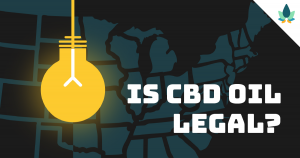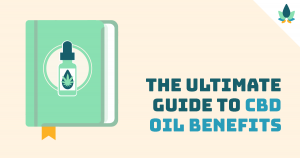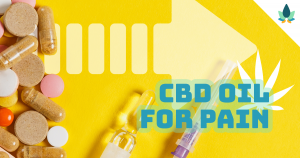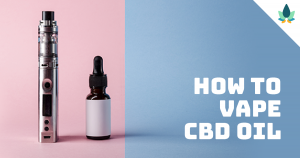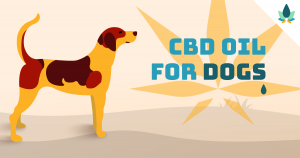You’ve learned about the power of CBD (cannabidiol) and you’re ready to incorporate it into your everyday lifestyle.
That’s a great first step!A natural next might be moving beyond tinctures and other more “traditional” modes of consumption, toward something more natural, and maybe even more fun: edibles.
Even better? Learning how to make your own CBD edibles!
In this piece, we’ll cover all the basics to get you started, including why CBD oil for edibles makes sense, how they work, CBD edible recipes and more.
Ready to jump in? Great.
The Effects of CBD Edibles
Edible cannabis products are hardly new. In fact, if you’ve been around for any length of time, you’ve no doubt heard jokes about brownies and other baked goods that can be… well… “enhanced.” But just like any other marijuana product, edibles often contain high levels of THC — cannabis’ psychoactive component that is often accompanied by side effects that you may not be after. CBD edible benefits are wide-reaching — without the well-known side effects of THC. Many CBD users swear by CBD edibles for anxiety, CBD edibles for pain and other conditions that include:
CBD consumed in the edible form generally takes 1-3 hours to hit the bloodstream, whereas tinctures and vaped forms tend to be faster and shorter lived. Although symptom relief may take a bit longer, edibles may be a delicious, longer-lasting option for those looking for a standard maintenance dose.
Extra Benefits of CBD
Unlike THC, other benefits of consuming CBD comes from the hemp plant’s impressive antioxidant properties and Omega 3 and Omega 6 fatty acid content. That’s why CBD is often marketed as a health supplement just like other vitamins and minerals we depend on in our daily health regimens. (1)
Any substance that inhibits oxidation in the body is considered an “antioxidant”. Oxidation is a process inside the body that damages cells and can lead to many common health problems. (2)
While our bodies are able to produce antioxidants to block the process, external factors — think unhealthy diets, pollution, and more — often inhibit the production of these critical substances.
CBD acts as an antioxidant while interacting with the body’s endocannbinoid system, enhancing the effects of other antioxidants we consume from sources like fruits and vegetables. This results in reduced inflammation, reduced cell damage, and so much more.
Convinced that consuming CBD as an edible is right for your needs? Excellent! Let’s move on.
Where to Start: Find the Right Isolate or Extract Your Own
Whether you’re interested in how to make edibles with isolate, from purchased CBD oil or tinctures, or, would like to extract your own and start from scratch, you have options.
If you’d like to work with an isolate, do your research. Look for CBD extracted from the aerial parts of hemp plants from a manufacturer that can verify the amount of CBD and quality of their products.
Remember, the product you use will be mixed into a larger batch of other products, so you’ll need either an isolate with a higher level of CBD or a larger quantity with lower levels in order to see results. If you’re new to CBD, working with a product with a consistent amount of CBD may be a better place to start than extracting your own oil.
If starting from scratch is more up your alley, no problem. Be sure to check your state laws regarding the cultivation of cannabis plants before getting started.
To begin with, look for a strain of hemp plants that contain high levels of CBD and low levels of THC. Do research to establish how much CBD oil you can expect to extract from each plant to have a better idea of what you’re starting with, especially if consistency is key for your daily CBD needs.
You’ll likely need one cup of a high-quality carrier oil — often, virgin coconut oil is a good starting point, though, depending on your edible needs, extra virgin olive oil can be used — and approximately 14 grams of hemp buds. Tools to have on hand include a mason or canning jar, a candy thermometer, a saucepan, a washcloth, a towel, and a fine cheesecloth.
The following recipe, modified from Naturalon, is designed to maximize your extraction efforts. (3)
Maximize Your Extraction Efforts
- Use a coffee grinder to grind down the buds as fine as possible.
- Use a mason or canning jar to combine the 1 cup of carrier oil with the ground up hemp buds, and put the lid on the jar tightly.
- Place a washcloth in a saucepan (to prevent burning) under a few inches of water, placing the jar on top of the washcloth.
- Bring the water in the pan to a boil, leaving it to boil for 3 hours. Continue to watch the pan during this time and add more water as it evaporates. *NOTE: track the temperature during the process to ensure the water does not exceed 180 degrees C.
- During this time, use tongs to lift and shake the jar every 30 minutes.
- After three hours, turn off the stove top, and use a dry towel to cover the saucepan, allowing it to cool for 3 hours.
- Repeat steps 3-6 one more time, but leave the saucepan covered overnight this time.
- Continue to repeat the process as desired: the more times the process is repeated, the stronger the oil you extract will be.
- When you are satisfied with your final product, use a fine cheesecloth to strain the oil.
- Voila! Homemade CBD oil.
Regardless of your method, the product you have — either a purchased or homemade oil — can be used in a variety of products, which we’ll cover as we move on.
Cannabutter: How To Make CBD Butter
Cannabutter can be used in many recipes that call for butter, thereby infusing them with CBD. The process of how to make CBD butter — or cannabutter — is similar to extracting CBD oil, only it uses butter instead of carrier oil.
You’ll need hemp flowers — see disclaimer above about growing your own hemp. Many advocates recommend starting with a single flower, then working up as you decide the dosage that’s right for your health needs (a flower?
Yes. It is a common misconception that all hemp plants are male and do not flower). If you’d prefer to use leaves, that is also acceptable. You’ll also need 1 pound of unsalted butter, 4 cups of water, 2 fine cheesecloths, cooking utensils, a saucepan, a mixing bowl, a metal colander, and airtight containers.
Recipe: CBD Butter
- Melt the butter in the 4 cups of water over low heat, adding the hemp flower or flowers after the mixture melts.
- Continue simmering — never boiling — on low heat for 3-4 hours, stirring every 30 minutes.
- If the hemp flower floats too close to the bottom of the pan, or the mixture becomes too thick, add small amounts of water gradually.
- After 3-4 hours, most of the water should have evaporated. Remove the pan from heat and allow the mixture to cool.
- After you can handle the mixture, pour it into a colander lined with cheesecloth, and held over the bowl, pressing on it to allow the butter to pass through the cloth. If necessary, lift and squeeze the cheesecloth to maximize the amount of butter extracted.
- Place the bowl into the refrigerator until the butter solidifies. The butter should separate from the water.
- Lift the butter away from the bowl, allowing excess water to remain in the bowl. Dry off the butter that you remove and place it in an airtight container, storing it in the fridge to be used as needed.
If making your own isn’t of interest, searching for CBD butter for sale is always a legitimate option for moving forward.
To Bake or Not To Bake (And Other Things You Should Know)
It’s a well-known fact that certain substances — like alcohol — begin to evaporate and lose their desired effects when used in cooking and/or baking.
DOES THIS APPLY TO CBD?
Yes — but that doesn’t mean it isn’t doable. Just keep in mind that CBD starts to evaporate somewhere between 320 and 350 degrees Fahrenheit. When baking, you may need to reduce the temperature and bake for longer time periods.
A FEW OTHER THINGS TO KEEP IN MIND:
- Warming CBD below its evaporation threshold (320-350 degrees Fahrenheit) can increase its effects.
- When the temperature of CBD increases, so does its bitterness.
- CBD must be infused in a carrier oil, as the recipes above indicate. While it can be added to alcoholic drinks, they are water-based, which means it may not mix as well as you’d like.
- When cooking or baking with CBD, stir the oil or butter as much as possible to create an even distribution.
Make sense? Great!
Let’s move onto an actual recipe by learning how to make CBD isolate gummies!
Make Your Own CBD Gummies
Full-spectrum hemp gummies are a great starting point because CBD isolate, tinctures or almost any other form can be used to produce delicious morsels that are easy to consume on-the-go.heck out our adapted CBD isolate gummies recipe below. (4)
Recipe: CBD Gummies
INGREDIENTS:
- 1 oz CBD. You can use CBD in an oil format, OR from a tincture, at the dose that’s best for you.
- Three tablespoons of the flavoring of your choice — honey is a simple place to start.
- ¾ cup juice of your choice: cherry, apple, pear, etc.
- ½ cup of coconut water.
- 1 ½ Tbsp gelatin
- ⅛ tsp salt

NOW FOR THE FUN PART:
- Bring coconut water to a boil in a small pan.
- Add the juice you chose, salt and honey. Stir until smooth with a consistent texture.
- Bring the mixture back to a boil, and leave it to simmer.
- Add gelatin, whisking constantly for four minutes.
- Add CBD and whisk until fully blended.
- Remove from heat.
- Using a food-grade funnel, pour the mixture into a condiment bottle, holding the bottle with an oven mitt.
- Squeeze mixture quickly into the gummy mold of your choice (it doesn’t have to be bears!)
- Place filled molds in the refrigerator.
- After the gummies are set, place them in an airtight container.
- Determine dose by dividing the CBD dose incorporated by the total number of gummies produced.
ENJOY!
Recipe: Chocolate Chip Pretzel Cookies
INGREDIENTS:
- ½ cup cannabutter
- ½ cup sugar
- ¼ cup packed light brown sugar
- 2 tsp vanilla extract
- 1 egg
- 1 ¾ cup flour
- ½ tsp baking soda
- ½ tsp salt
- ¾ cup milk chocolate chips
- ¼ cup crushed pretzels
LET’S BAKE!
- Preheat oven to 325 degrees Fahrenheit (remember, less heat is best!)
- Line baking sheet with parchment paper
- Melt cannabutter in the microwave.
- Allow butter to cool for 10 minutes
- Mix butter, sugar and brown sugar in a stand mixer until combined.
- Add vanilla and egg.
- In a separate bowl, combine flour, baking soda, and salt.
- Slowly add flour mixture to mixer bowl.
- Mix until combined.
- Fold in chocolate chips and pretzels
- Place rounded tablespoons of dough on baking sheets.
- Bake for 12-15 minutes or until cookies are set.
- Determine the CBD dose of each cookie by dividing the overall CBD dose into the number of cookies yielded.
Extra Fun: Everyday Edibles
Not a big baker? That’s okay! You can use CBD oil and/or butter in a variety of foods you already consume on a regular basis.
Some basic ideas could include:
Add to sauces, from Italian pasta dishes to spicy Indian dishes, each of which could mask the flavor of the oil.
Drizzle over roasted vegetables and potatoes in the oven (remember, low heat is best).
Drizzle melted butter over garlic bread, popcorn and more.
Add cannabutter to basic desserts like Rice Krispie Treats.
Consider mixing in alcoholic beverages. (Remember, it may not “combine” as planned and may take practice.)
Add cannabutter to your regular baking routine.
Add cannabutter to boxed cake mixes, replacing regular butter, to create CBD cake pops.
The options are endless!
CBD Edibles for Pets
To date, the FDA has not approved cannabis or CBD products for pets. Additionally, the American Veterinary Medical Association has taken no official stance on the topic.
Currently, veterinarians are not permitted to write prescriptions for or advise pet owners to allow their pets to consume cannabinoid-rich products. This is likely because pets — especially dogs — can be overly sensitive to THC.
CBD, on the other hand, does not seem to affect pets the same way and may even provide relief to conditions that pets suffer like their human counterparts (anxiety, arthritis, cancer and more). A market of dog CBD edibles has begun to crop up as a result.
If you make your own dog treats, you may consider adding CBD in the same way you would to human recipes, keeping in mind that there is no “official” word on the safety of the practice. Various dog CBD edibles are also available at pet stores across the country, ranging from “traditional” dog treats to infused bacon and beyond.
How to Make CBD Dog Treats
Find the Best CBD Edibles Online
If you’d rather purchase CBD infused edibles, that’s okay too! Just like purchasing CBD on its own, be sure to research the manufacturer’s background and read reviews to ensure you feel comfortable moving forward.
Long gone are the days of relying on questionable tasting CBD tinctures and supplements, creating your own edibles are easier than ever. Have a favorite recipe? Share it in the comments below!


